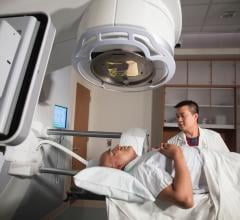
March 9, 2009 — Researches recently reported that the use of 3D ultrasound with the Resonant Medical’s Clarity Breast System provided enhanced image information to enable radiation oncologists to better define the treatment region when delivering partial breast irradiation treatment (PBI) for breast cancer, as reported in the February 1, 2009 issue of the International Journal of Radiation Oncology*Biology*Physics.
The Clarity Breast System reportedly marks the first application of 3D ultrasound technology to Image-Guided Radiation Therapy (IGRT) and was developed by Resonant Medical.
The study, “3D Ultrasound Can Contribute to Planning CT to Define the Target for Partial Breast Radiotherapy,” conducted at the Radiation Therapy Program, British Columbia Cancer Agency, Vancouver Island Centre and the University of British Columbia, examined 20 consecutive cases of early-stage breast cancer where the patients were treated with breast-conserving surgery. Researchers found that in 40 percent of cases, the variability between lumpectomy cavity contours was reduced when ultrasound was used instead of CT—the current standard of care for planning breast cancer treatment. In particular, 3D ultrasound proved to be particularly beneficial for imaging patients with dense breasts and small cavities.
“Precision in planning and the increased certainty that radiation is being delivered to the exact area where it is needed have never been more critical, with the percentage of patients opting for breast conservation therapy and PBI on the rise,” said Pauline Truong, M.D., CM, a researcher on the study. “Following this study, however, it is clear that the benefits of this technology could be applicable to not only PBI patients, but those undergoing whole breast radiation and electron boost therapy—potentially helping an even larger population of women with breast cancer.”
The Clarity Breast System marks the first application of 3D ultrasound technology to IGRT in breast cancer. The Clarity system was cleared by the U.S. Food and Drug Administration in 2004 for guidance in the treatment of prostate and breast cancers.
In addition to its application with treatment planning, the Clarity System is also used to image the lumpectomy cavity daily with each radiation treatment, to get an actual visual image and location of the tumor cavity on a regular basis. While the breast cancer radiation oncology community is aware that the location of the lumpectomy cavity target can change throughout the course of treatment, this issue is still largely unaccounted for in current treatment protocols. Clinical consequences can include delivery of radiation to healthy tissue, application of radiation too close to the chest wall or skin and, in some cases, under-treatment of certain areas. Clarity provides the first method of daily lumpectomy cavity monitoring that is based on visualization of the actual anatomy—rather than an estimation of the location of the cavity. This precision in planning and treatment could enable physicians to reduce the field of radiation they need to deliver, which is always preferable if clinically justified.
For more information: www.resonantmedical.com


 June 07, 2022
June 07, 2022 








